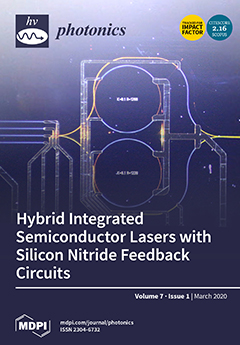Open AccessEditor’s ChoiceReview
Hybrid Integrated Semiconductor Lasers with Silicon Nitride Feedback Circuits
by
Klaus-J. Boller, Albert van Rees, Youwen Fan, Jesse Mak, Rob E. M. Lammerink, Cornelis A. A. Franken, Peter J. M. van der Slot, David A. I. Marpaung, Carsten Fallnich, Jörn P. Epping, Ruud M. Oldenbeuving, Dimitri Geskus, Ronald Dekker, Ilka Visscher, Robert Grootjans, Chris G. H. Roeloffzen, Marcel Hoekman, Edwin J. Klein, Arne Leinse and René G. Heideman
Cited by 83 | Viewed by 16036
Abstract
Hybrid integrated semiconductor laser sources offering extremely narrow spectral linewidth, as well as compatibility for embedding into integrated photonic circuits, are of high importance for a wide range of applications. We present an overview on our recently developed hybrid-integrated diode lasers with feedback
[...] Read more.
Hybrid integrated semiconductor laser sources offering extremely narrow spectral linewidth, as well as compatibility for embedding into integrated photonic circuits, are of high importance for a wide range of applications. We present an overview on our recently developed hybrid-integrated diode lasers with feedback from low-loss silicon nitride (Si
N
in SiO
) circuits, to provide sub-100-Hz-level intrinsic linewidths, up to 120 nm spectral coverage around a 1.55
m wavelength, and an output power above 100 mW. We show dual-wavelength operation, dual-gain operation, laser frequency comb generation, and present work towards realizing a visible-light hybrid integrated diode laser.
Full article
►▼
Show Figures





